
| Version | Summary | Created by | Modification | Content Size | Created at | Operation |
|---|---|---|---|---|---|---|
| 1 | Khalid Lamnawar | -- | 3841 | 2022-06-20 09:01:42 | | | |
| 2 | Rita Xu | -1 word(s) | 3840 | 2022-06-20 10:48:03 | | |
Video Upload Options
In a circular economy context with the dual problems of depletion of natural resources and the environmental impact of a growing volume of wastes, it is of great importance to focus on the recycling process of multilayered plastic films. First to the general concepts and summary of plastic waste management in general, making emphasis on the multilayer films recycling process. Then, in the second part, the focus is dealing with multilayer films manufacturing process, including the most common materials used for agricultural applications, their processing, and the challenges of their recycling, recyclability, and reuse. Hitherto, some prospects are discussed from eco-design to mechanical or chemical recycling approaches.
1. Introduction
1.1. Polymer-Based Flexible Films Waste Management
1.2. End-of-Life Treatment of Plastic Waste
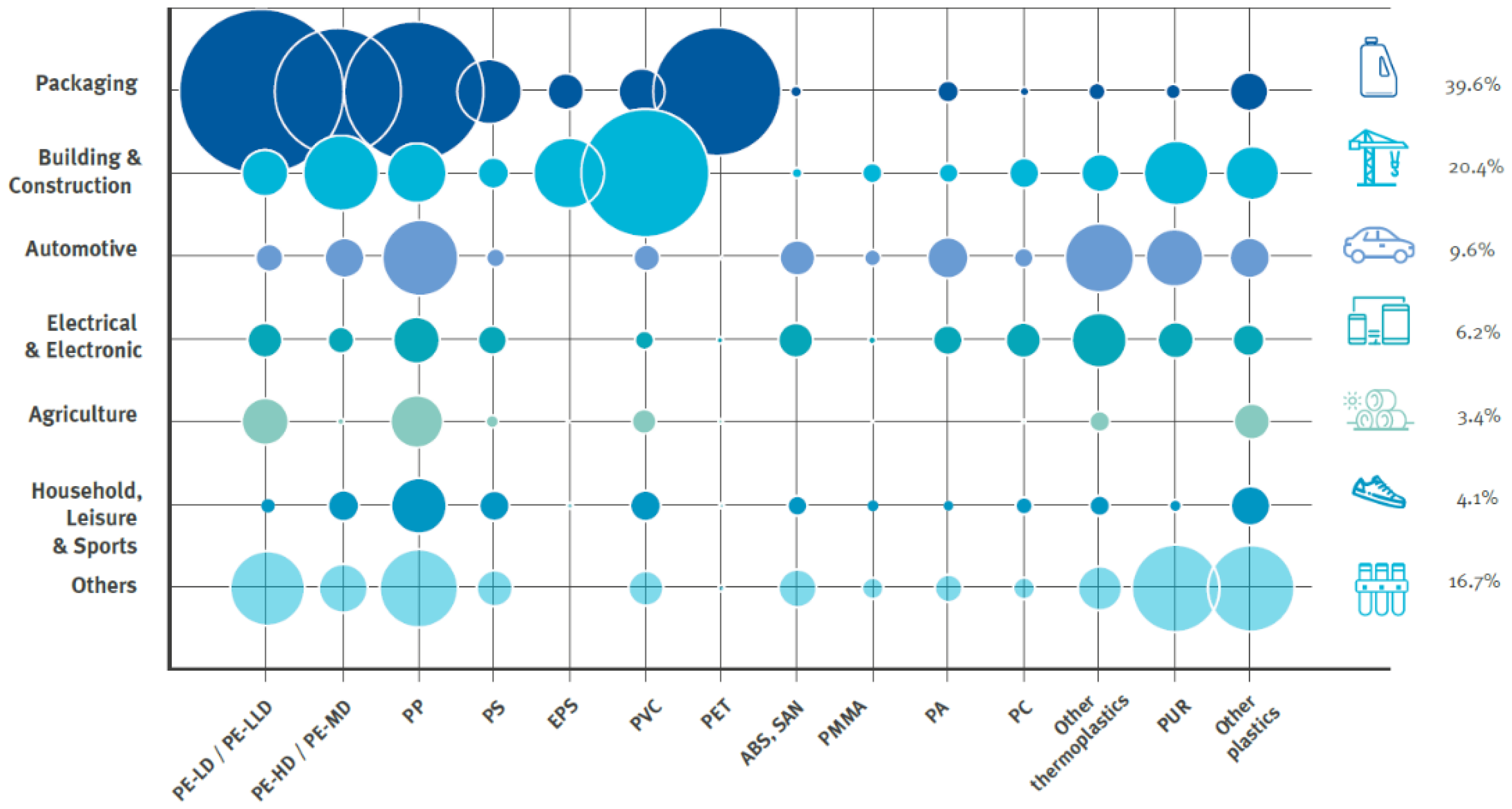
2. Processing of Multilayer Films and Applications
2.1. Coextrusion: Principle and Technologies
2.1.1. Cast Film Coextrusion
-
Potential reduction in expensive polymer materials by controlling the polymer domain location, continuity, and thickness.
-
Incorporation of recycled materials at the internal layers without degrading the film properties.
-
Reduce the film thickness maintaining the mechanical, transport, and/or optical film properties.
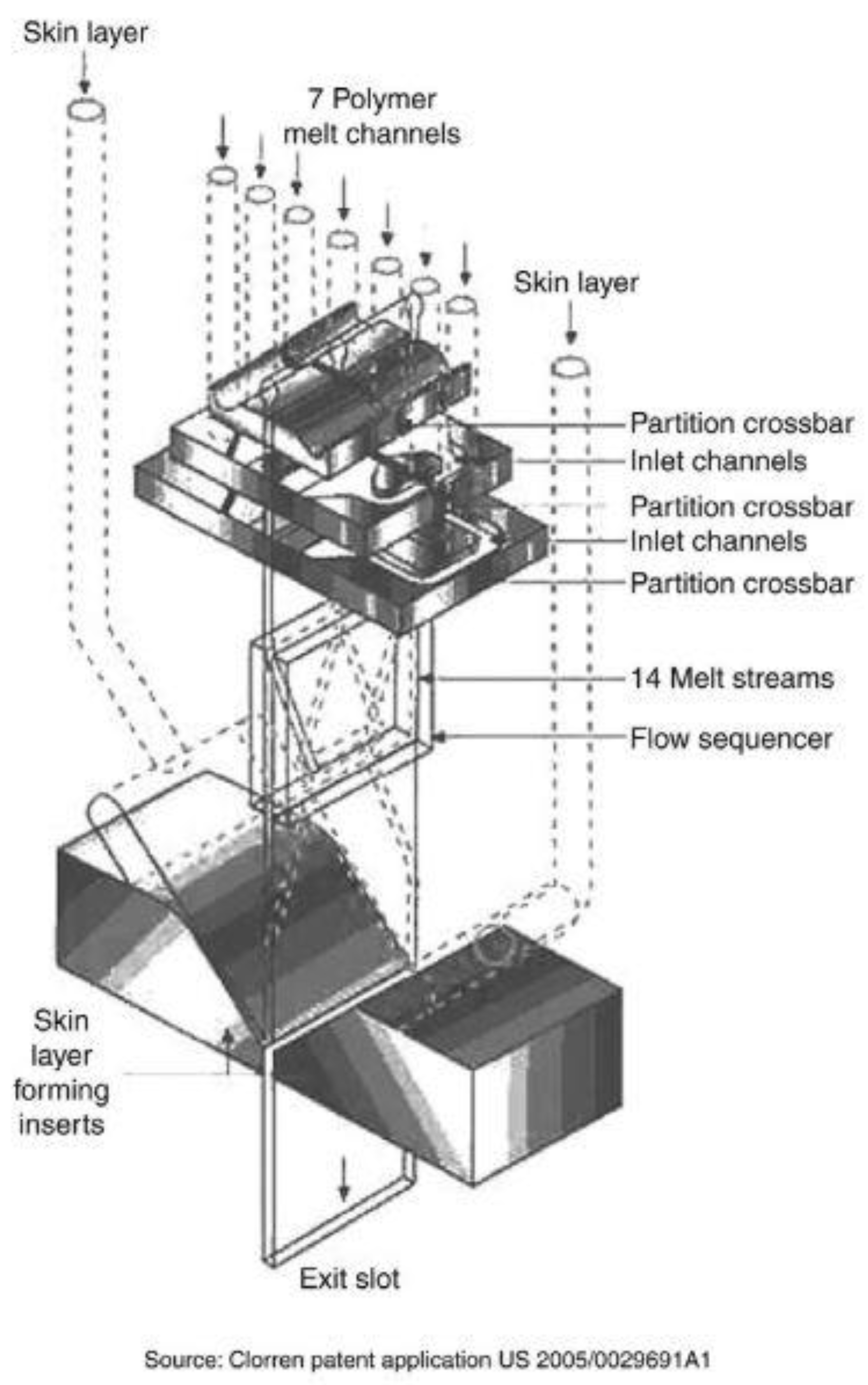
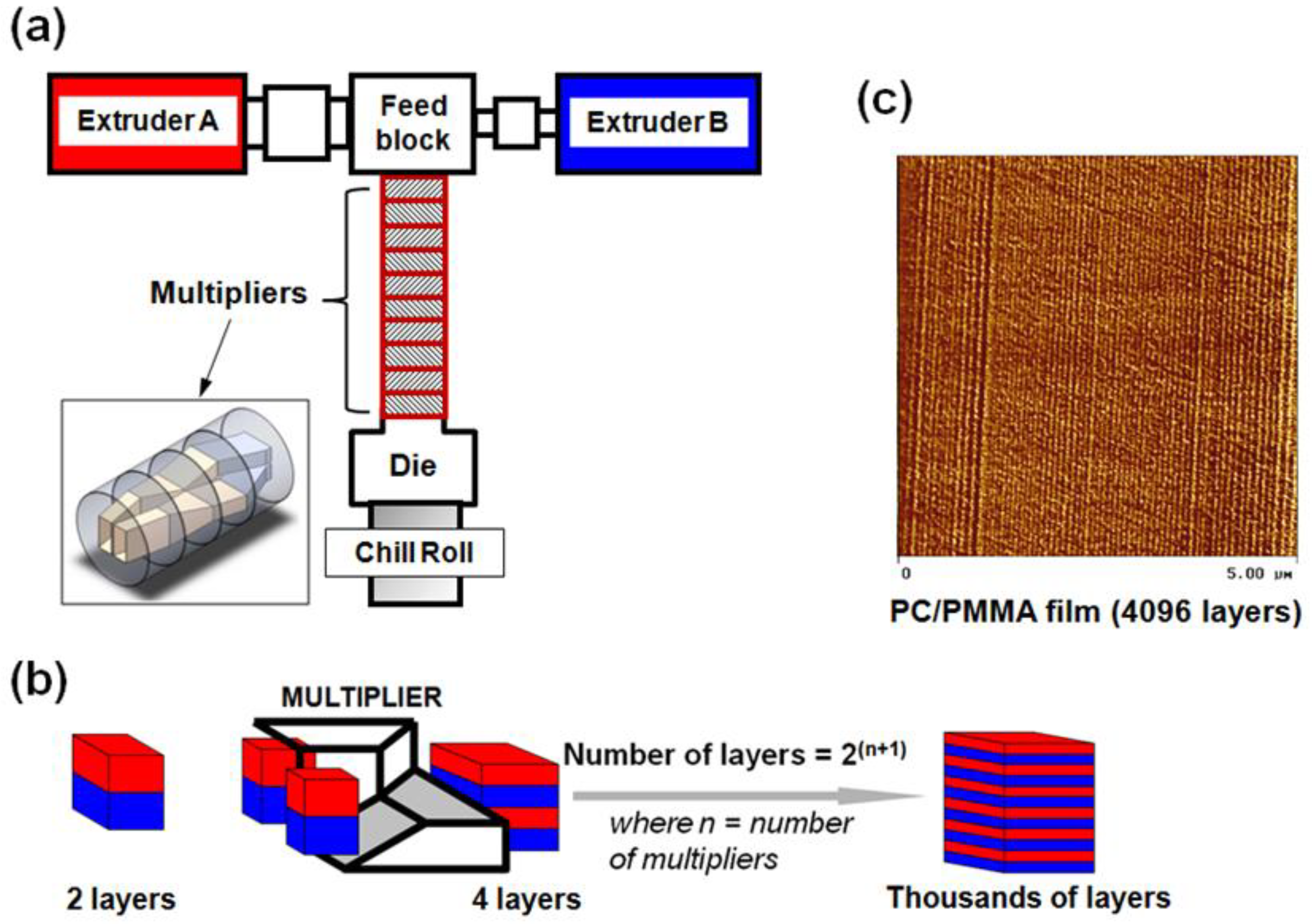
2.1.2. Blown Film Coextrusion
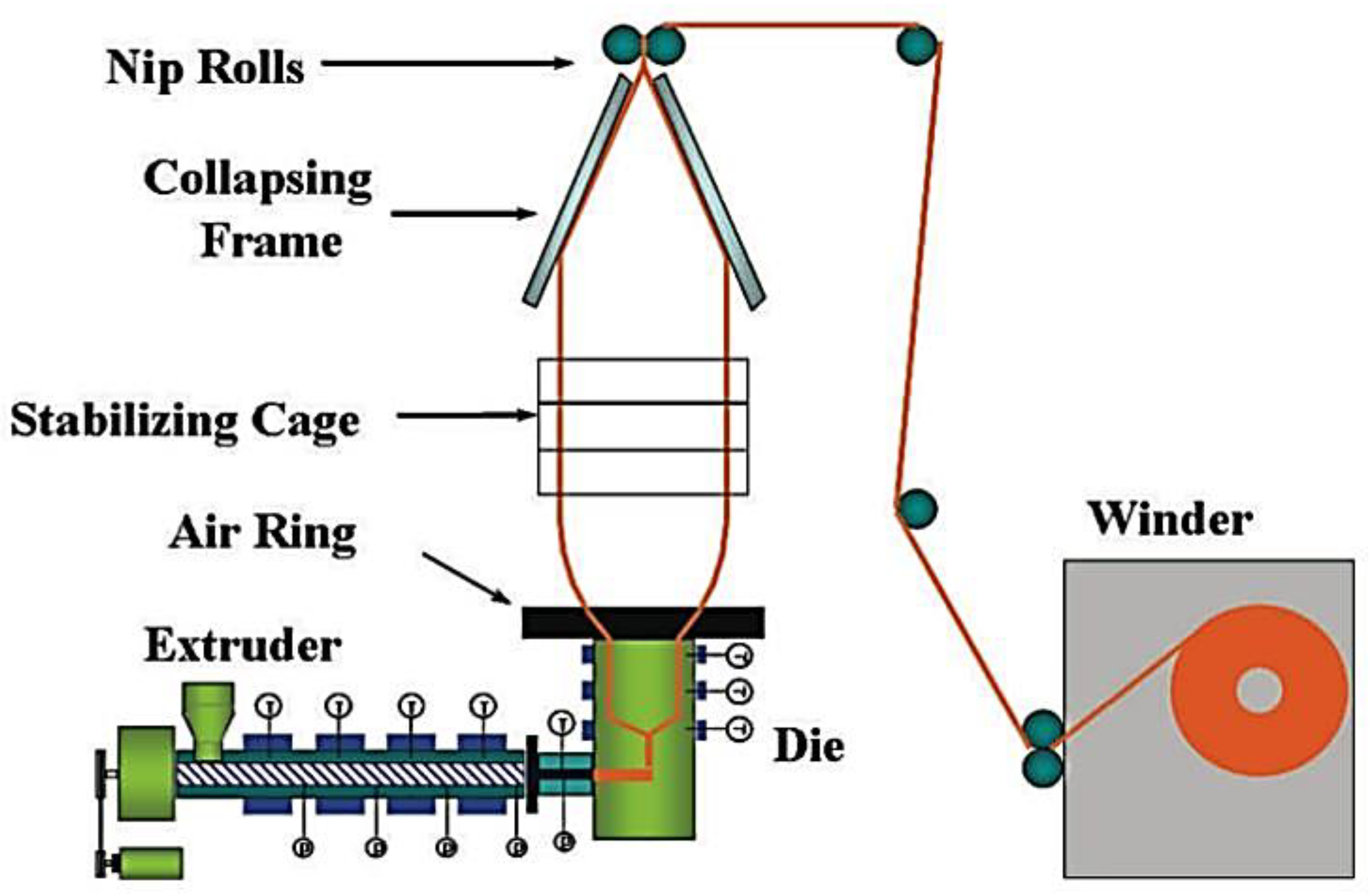

-
Protection of the thinner microlayers as they flow from the feedblock to and around the die.
-
Geometry design that allows the layers to flow slowly through the die while maintaining the microlayered structure

2.2. Multilayer Films in Agricultural Applications
| Protective Cultivation Films | Livestock Farming Films |
|---|---|
| Low tunnel Greenhouse and tunnel Mulching Direct covering Nursery film Covering vineyards |
Silage films Bale wrapping films Protection films |
-
Greenhouse covering: Greenhouse are films used for crop protection (Figure 6). Films with a range of 100 µm to 1 µm that answer the basic requirements of thermal protection, light transmission, and direct or artificial flood lighting.
-
Mulching: This technique consists in covering the soil (where the cultivation has been planted) with a layer that protects seedlings and young plants (Figure 7). The films used are transparent or opaque, white, colored, or black with range thickness of 20–50 µm, which are mechanically laid on the soil.
-
Low tunnels: They consist of small arch-shaped support structures covered by plastic films with the objective to create a microclimate suitable for cultivation (Figure 8). Films of about 60–100 µm thickness are generally installed.
-
Silage films: Silage is a technique used for conservation of wet forage by acidification of the environment protected from the ambient air (Figure 9). Depending on their specific application, films with a range between 35 and 100 µm are installed.
-
Bale wrap films: Wrapping films are used for individually or continuously wrapping cylindrical or square bales of fodder in order to obtain an airtight envelop, which allow the anaerobic fermentation process necessary for the production of silage (Figure 10). Films can be black, white, and other colors (green and brown) with thickness range of 20–30 µm.
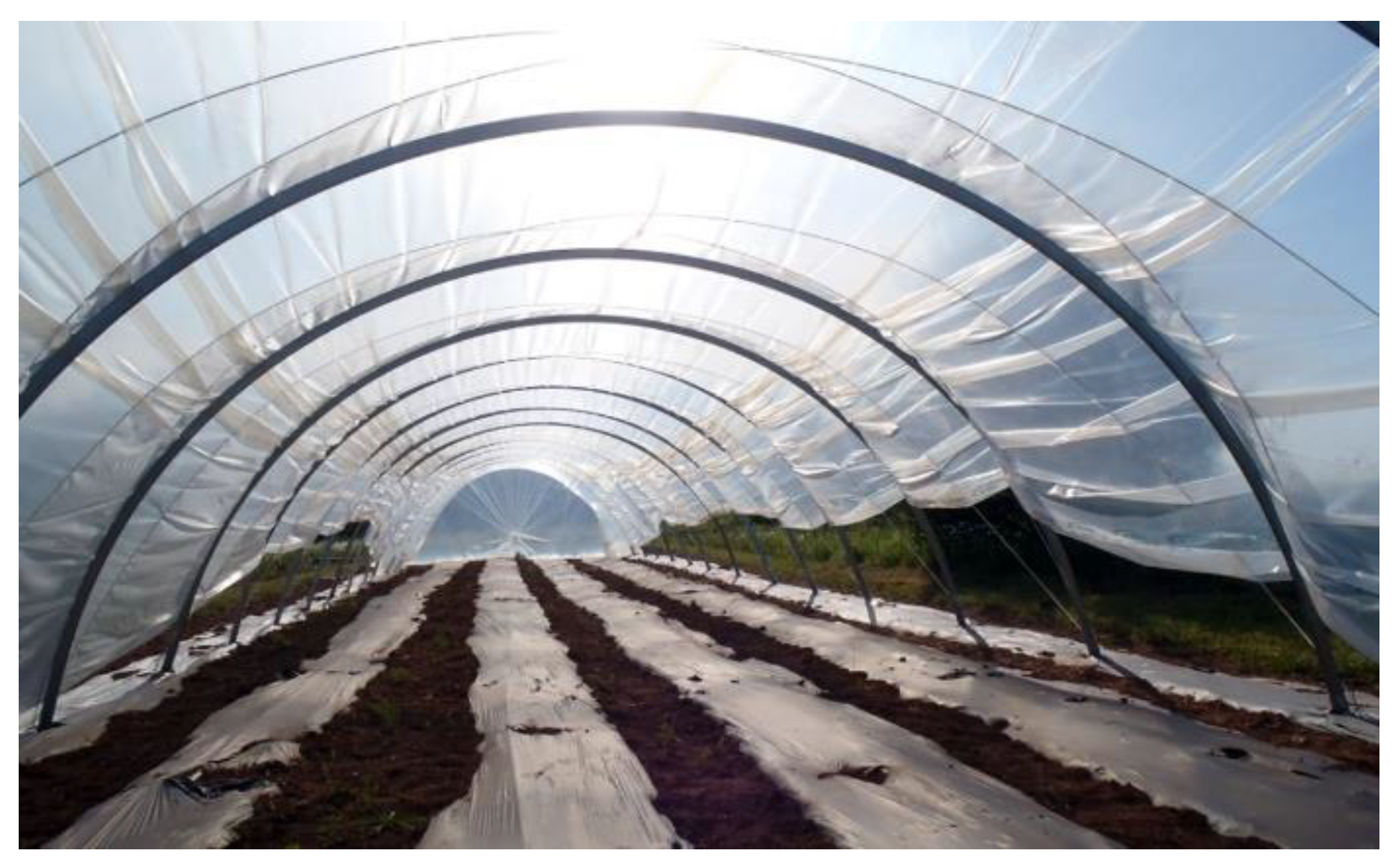
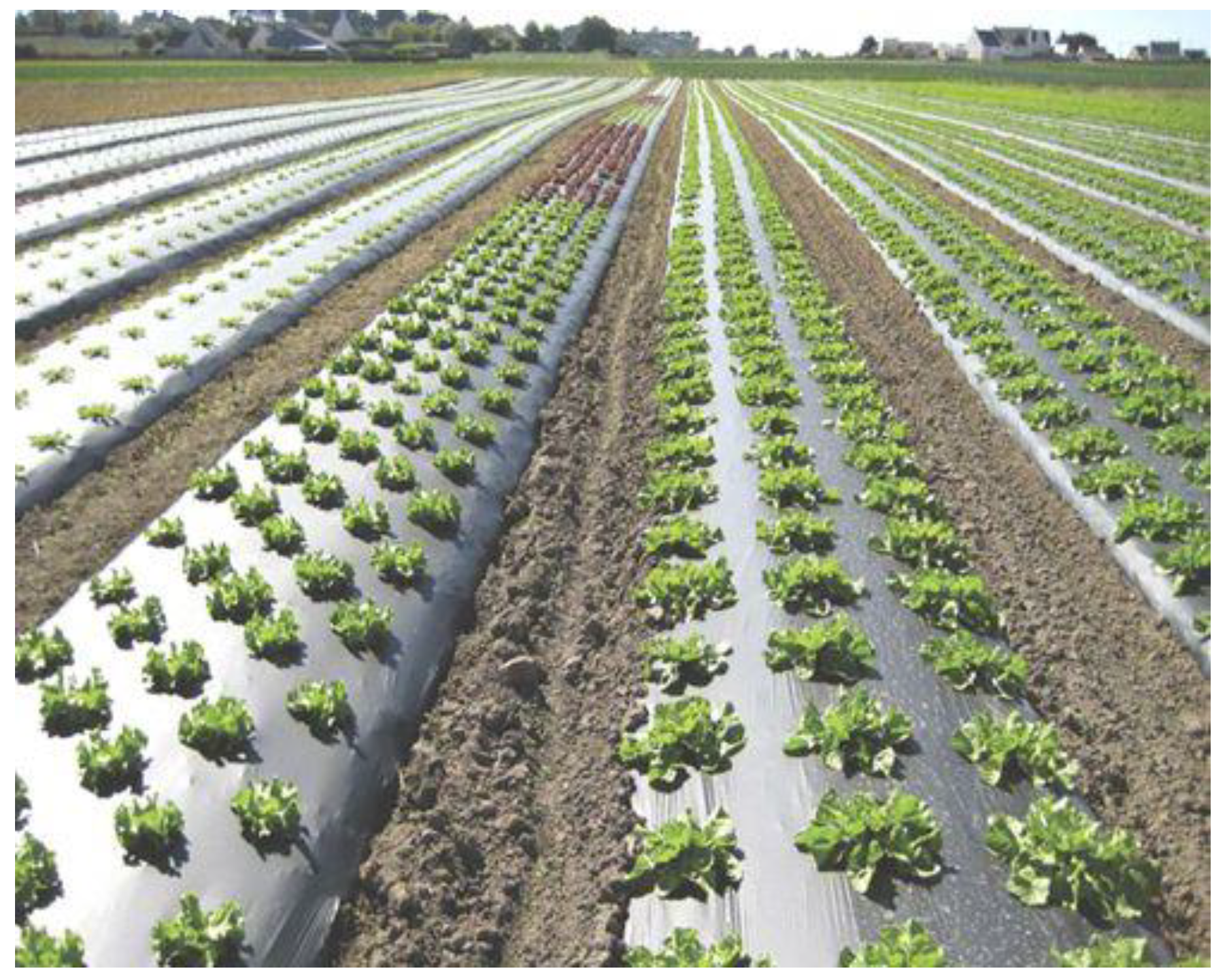
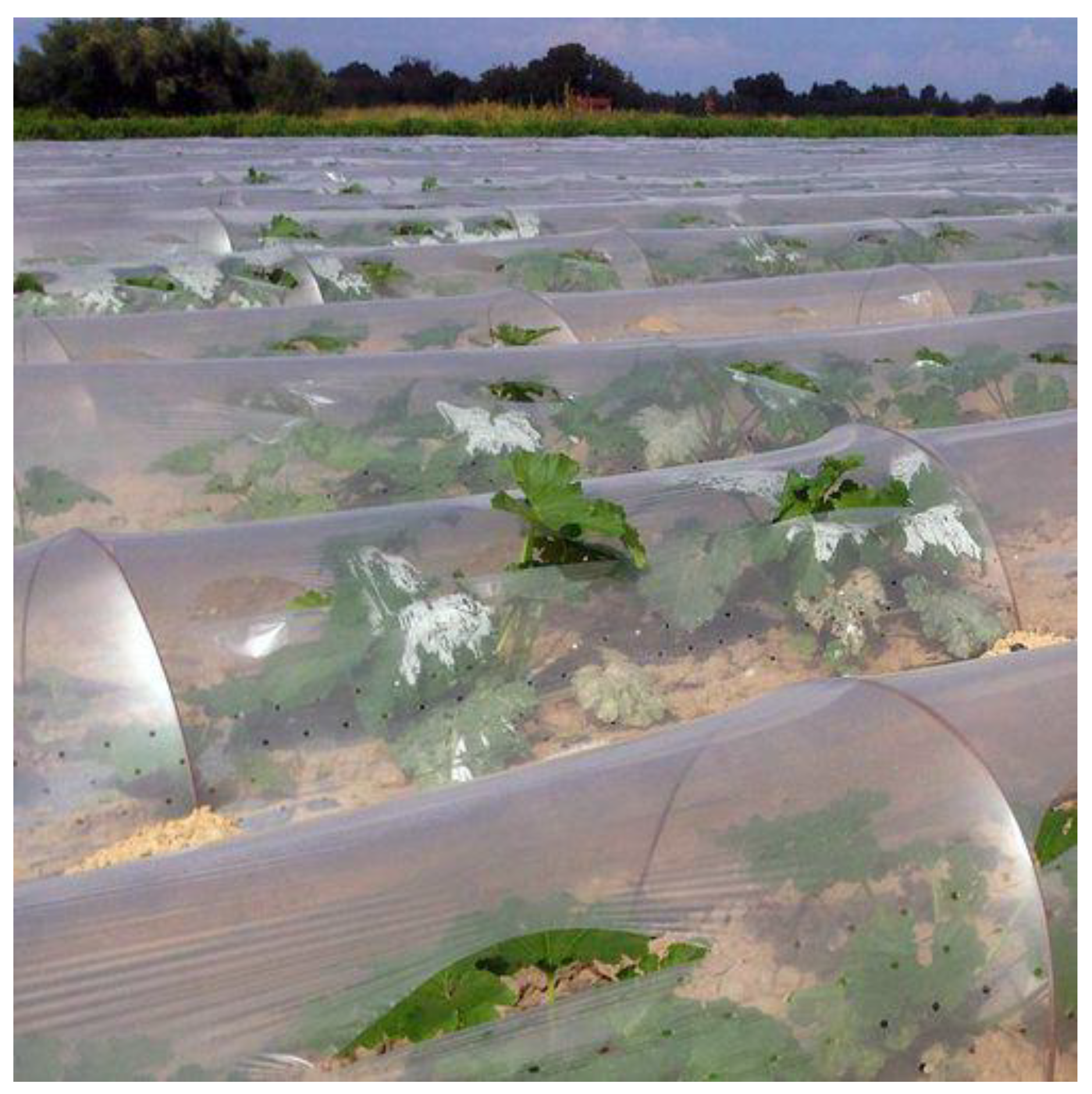
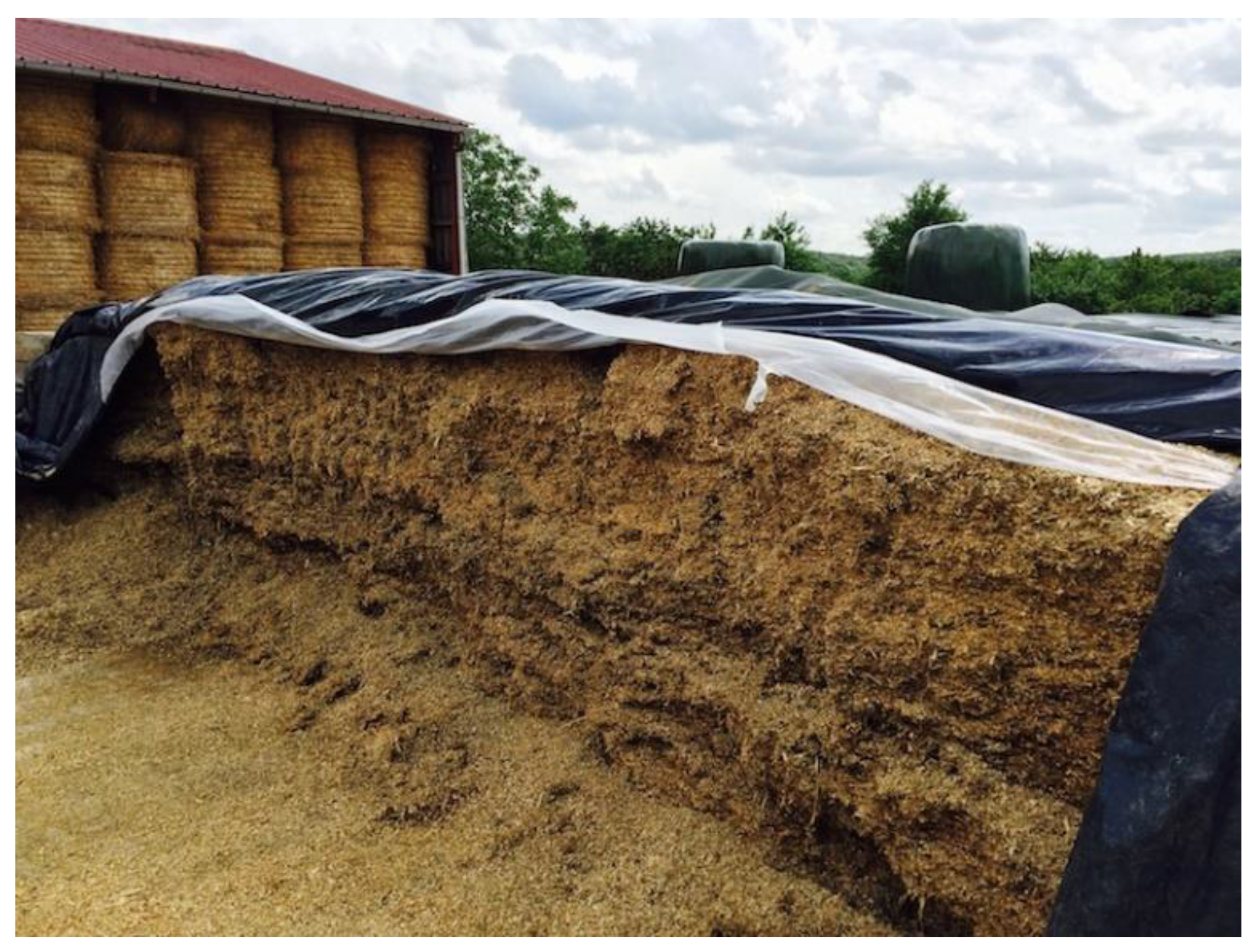

References
- Plastics Europe—Association of Plastic Manufacturers. Plastics—The Facts 2020; PlasticEurope: Brussels, Belgium, 2020; pp. 1–64.
- Kaiser, K.; Schmid, M.; Schlummer, M. Recycling of Polymer-Based Multilayer Packaging: A Review. Recycling 2017, 3, 1.
- Horodytska, O.; Valdés, F.J.; Fullana, A. Plastic Flexible Films Waste Management—A State of Art Review. Waste Manag. 2015, 77, 413–425.
- Zhang, X.; Xu, Y.; Zhang, X.; Wu, H.; Shen, J.; Chen, R.; Xiong, Y.; Li, J.; Guo, S. Progress on the Layer-by-Layer Assembly of Multilayered Polymer Composites: Strategy, Structural Control and Applications. Prog. Polym. Sci. 2019, 89, 76–107.
- Mangaraj, S.; Goswami, T.K.; Mahajan, P.V. Applications of Plastic Films for Modified Atmosphere Packaging of Fruits and Vegetables: A Review. Food Eng. Rev. 2009, 1, 133.
- Shemesh, R.; Krepker, M.; Goldman, D.; Danin-Poleg, Y.; Kashi, Y.; Nitzan, N.; Vaxman, A.; Segal, E. Antibacterial and Antifungal LDPE Films for Active Packaging. Polym. Adv. Technol. 2015, 26, 110–116.
- Beigmohammadi, F.; Peighambardoust, S.H.; Hesari, J.; Azadmard-Damirchi, S.; Peighambardoust, S.J.; Khosrowshahi, N.K. Antibacterial Properties of LDPE Nanocomposite Films in Packaging of UF Cheese. LWT-Food Sci. Technol. 2016, 65, 106–111.
- Gumiero, M.; Peressini, D.; Pizzariello, A.; Sensidoni, A.; Iacumin, L.; Comi, G.; Toniolo, R. Effect of TiO2 Photocatalytic Activity in a HDPE-Based Food Packaging on the Structural and Microbiological Stability of a Short-Ripened Cheese. Food Chem. 2013, 138, 1633–1640.
- López-Rubio, A.; Almenar, E.; Hernandez-Muñoz, P.; Lagarón, J.M.; Catalá, R.; Gavara, R. Overview of Active Polymer-Based Packaging Technologies for Food Applications. Food Rev. Int. 2004, 20, 357–387.
- Nisticò, R. Polyethylene Terephthalate (PET) in the Packaging Industry. Polym. Test. 2020, 90, 106707.
- Gomes, T.S.; Visconte, L.L.Y.; Pacheco, E.B.A.V. Life Cycle Assessment of Polyethylene Terephthalate Packaging: An Overview. J. Polym. Environ. 2019, 27, 533–548.
- Nayak, S.; Khuntia, S.K. Development and Study of Properties of Moringa Oleifera Fruit Fibers/ Polyethylene Terephthalate Composites for Packaging Applications. Compos. Commun. 2019, 15, 113–119.
- Siracusa, V.; Blanco, I. Bio-Polyethylene (Bio-PE), Bio-Polypropylene (Bio-PP) and Bio-Poly(Ethylene Terephthalate) (Bio-PET): Recent Developments in Bio-Based Polymers Analogous to Petroleum-Derived Ones for Packaging and Engineering Applications. Polymers 2020, 12, 1641.
- Mooninta, S.; Poompradub, S.; Prasassarakich, P. Packaging Film of PP/LDPE/PLA/Clay Composite: Physical, Barrier and Degradable Properties. J. Polym. Environ. 2020, 28, 3116–3128.
- Tornuk, F.; Hancer, M.; Sagdic, O.; Yetim, H. LLDPE Based Food Packaging Incorporated with Nanoclays Grafted with Bioactive Compounds to Extend Shelf Life of Some Meat Products. LWT-Food Sci. Technol. 2015, 64, 540–546.
- Mulla, M.; Ahmed, J.; Al-Attar, H.; Castro-Aguirre, E.; Arfat, Y.A.; Auras, R. Antimicrobial Efficacy of Clove Essential Oil Infused into Chemically Modified LLDPE Film for Chicken Meat Packaging. Food Control 2017, 73, 663–671.
- WRAP (Waste and Resource Action Programme). Plastics Market Situation Report; WRAP Publishing: Banbury, UK, 2016; pp. 1–29.
- Plastics Europe. Plastics—The Facts 2019; PlasticEurope: Brussels, Belgium, 2019.
- Schyns, Z.O.G.; Shaver, M.P. Mechanical Recycling of Packaging Plastics: A Review. Macromol. Rapid Commun. 2021, 42, 2000415.
- Ragaert, K.; Delva, L.; Van Geem, K. Mechanical and Chemical Recycling of Solid Plastic Waste. Waste Manag. 2017, 69, 24–58.
- Hestin, M.; Mitsios, A.; Said, S.A.; Fouret, F.; Berwald, A.; Senlis, V. Deloitte Sustainability Blueprint for Plastics Packaging Waste: Quality Sorting & Recycling; Deloitte: London, UK, 2017.
- Biji, K.B.; Ravishankar, C.N.; Mohan, C.O.; Srinivasa Gopal, T.K. Smart Packaging Systems for Food Applications: A Review. J. Food Sci. Technol. 2015, 52, 6125–6135.
- Zhong, Y.; Godwin, P.; Jin, Y.; Xiao, H. Biodegradable Polymers and Green-Based Antimicrobial Packaging Materials: A Mini-Review. Adv. Ind. Eng. Polym. Res. 2020, 3, 27–35.
- Eilert, S.J. New Packaging Technologies for the 21st Century. Meat Sci. 2005, 71, 122–127.
- European Parliament and Council. European Parliament and Council Directive 2008/98/EC of the European Parliament and of the Council of 19 November 2008 on Waste and Repealing Certain Directives (Waste Framework). Available online: https://eur-lex.europa.eu/legal-content/EN/TXT/PDF/?uri=CELEX:32008L0098&rid=9 (accessed on 15 May 2022).
- Rigamonti, L.; Grosso, M.; Møller, J.; Martinez Sanchez, V.; Magnani, S.; Christensen, T.H. Environmental Evaluation of Plastic Waste Management Scenarios. Resour. Conserv. Recycl. 2014, 85, 42–53.
- Singh, P.; Sharma, V.P. Integrated Plastic Waste Management: Environmental and Improved Health Approaches. Waste Manag. Resour. Util. 2016, 35, 692–700.
- Idumah, C.I.; Nwuzor, I.C. Novel Trends in Plastic Waste Management. SN Appl. Sci. 2019, 1, 1402.
- Pan, D.; Su, F.; Liu, C.; Guo, Z. Research Progress for Plastic Waste Management and Manufacture of Value-Added Products. Adv. Compos. Hybrid Mater. 2020, 3, 443–461.
- Turku, I.; Kärki, T.; Rinne, K.; Puurtinen, A. Characterization of Plastic Blends Made from Mixed Plastics Waste of Different Sources. Waste Manag. Res. 2017, 35, 200–206.
- Plastics Europe. An Analysis of European Plastics Production, Demand and Waste Data. In Plasts—Facts 2015; PlasticEurope: Brussels, Belgium, 2015; p. 33.
- Bondon, A.; Lamnawar, K.; Maazouz, A. Experimental Investigation of a New Type of Interfacial Instability in a Reactive Coextrusion Process. Polym. Eng. Sci. 2015, 55, 2542–2552.
- Lu, B.; Alcouffe, P.; Sudre, G.; Pruvost, S.; Serghei, A.; Liu, C.; Maazouz, A.; Lamnawar, K. Unveiling the Effects of In Situ Layer–Layer Interfacial Reaction in Multilayer Polymer Films via Multilayered Assembly: From Microlayers to Nanolayers. Macromol. Mater. Eng. 2020, 305, 2000076.
- Messin, T.; Follain, N.; Guinault, A.; Sollogoub, C.; Gaucher, V.; Delpouve, N.; Marais, S. Structure and Barrier Properties of Multinanolayered Biodegradable PLA/PBSA Films: Confinement Effect via Forced Assembly Coextrusion. ACS Appl. Mater. Interfaces 2017, 9, 29101–29112.
- Messin, T.; Follain, N.; Guinault, A.; Miquelard-Garnier, G.; Sollogoub, C.; Delpouve, N.; Gaucher, V.; Marais, S. Confinement Effect in PC/MXD6 Multilayer Films: Impact of the Microlayered Structure on Water and Gas Barrier Properties. J. Membr. Sci. 2017, 525, 135–145.
- Xu, Y.; Qin, J.; Shen, J.; Guo, S.; Lamnawar, K. Scratch Behavior and Mechanical Properties of Alternating Multi-Layered PMMA/PC Materials. Wear 2021, 486–487, 204069.
- Xu, S.; Wen, M.; Li, J.; Guo, S.; Wang, M.; Du, Q.; Shen, J.; Zhang, Y.; Jiang, S. Structure and Properties of Electrically Conducting Composites Consisting of Alternating Layers of Pure Polypropylene and Polypropylene with a Carbon Black Filler. Polymer 2008, 49, 4861–4870.
- Liu, S.; Li, C.; Wu, H.; Guo, S. Novel Structure to Improve Mechanical Properties of Polymer Blends: Multilayered Ribbons. Ind. Eng. Chem. Res. 2020, 59, 20221–20231.
- Mackey, M.; Hiltner, A.; Baer, E.; Flandin, L.; Wolak, M.A.; Shirk, J.S. Enhanced Breakdown Strength of Multilayered Films Fabricated by Forced Assembly Microlayer Coextrusion. J. Phys. Appl. Phys. 2009, 42, 175304.
- Ponting, M.; Burt, T.M.; Korley, L.T.J.; Andrews, J.; Hiltner, A.; Baer, E. Gradient Multilayer Films by Forced Assembly Coextrusion. Ind. Eng. Chem. Res. 2010, 49, 12111–12118.
- Li, Z.; Olah, A.; Baer, E. Micro- and Nano-Layered Processing of New Polymeric Systems. Prog. Polym. Sci. 2020, 102, 101210.
- Carr, J.M.; Langhe, D.S.; Ponting, M.T.; Hiltner, A.; Baer, E. Confined Crystallization in Polymer Nanolayered Films: A review. J. Mater. Res. 2012, 27, 1326–1350.
- Ponting, M.; Hiltner, A.; Baer, E. Polymer Nanostructures by Forced Assembly: Process, Structure, and Properties. Macromol. Symp. 2010, 294, 19–32.
- Lamnawar, K.; Zhang, H.; Maazouz, A. Coextrusion of Multilayer Structures, Interfacial Phenomena. Encycl. Polym. Sci. Technol. (Ed.) 2013.
- Baer, E.; Zhu, L. 50th Anniversary Perspective: Dielectric Phenomena in Polymers and Multilayered Dielectric Films. Macromolecules 2017, 50, 2239–2256.
- Lu, B.; Lamnawar, K.; Maazouz, A.; Sudre, G. Critical Role of Interfacial Diffusion and Diffuse Interphases Formed in Multi-Micro-/Nanolayered Polymer Films Based on Poly(Vinylidene Fluoride) and Poly(Methyl Methacrylate). ACS Appl. Mater. Interfaces 2018, 10, 29019–29037.
- Lu, B.; Zhang, H.; Maazouz, A.; Lamnawar, K. Interfacial Phenomena in Multi-Micro-/Nanolayered Polymer Coextrusion: A Review of Fundamental and Engineering Aspects. Polymers 2021, 13, 417.
- Lu, B.; Bondon, A.; Touil, I.; Zhang, H.; Alcouffe, P.; Pruvost, S.; Liu, C.; Maazouz, A.; Lamnawar, K. Role of the Macromolecular Architecture of Copolymers at Layer–Layer Interfaces of Multilayered Polymer Films: A Combined Morphological and Rheological Investigation. Ind. Eng. Chem. Res. 2020, 59, 22144–22154.
- Lu, B.; Lamnawar, K.; Maazouz, A. Influence of in Situ Reactive Interphase with Graft Copolymer on Shear and Extensional Rheology in a Model Bilayered Polymer System. Polym. Test. 2017, 61, 289–299.
- Langhe, D.; Ponting, M. Coextrusion Processing of Multilayered Films. In Manufacturing and Novel Applications of Multilayer Polymer Films, 1st ed.; William Andrew: New York, NY, USA, 2016; pp. 16–45. ISBN 9780323374668.
- Crabtree, S.; Dooley, J.; Robacki, J.; Lee, P.C.; Wrisley, R.; Pavlicek, C. Producing Microlayer Blow Molded Structures Using Layer Multiplication and Unique Die Head Technology. In Proceedings of the Society of Plastics Engineers—27th Annual Blow Molding Conference, ABC 2011, Chicago, IL, USA, 12–13 October 2011.
- López, J.C.; Pérez-Parra, J.; Morales, M.A. Plastics in Agriculture-Applications and Usages Handbook; CEPLA–Plastics Europe: Almería, Spain, 2009; ISBN 978-84-95531-47-6.
- Briassoulis, D.; Hiskakis, M.; Scarascia, G.; Picuno, P.; Delgado, C.; Dejean, C. Labeling Scheme for Agricultural Plastic Wastes in Europe. Qual. Assur. Saf. Crops Foods 2010, 2, 93–104.
- Scarascia-Mugnozza, G.; Sica, C.; Russo, G. Plastic Materials in European Agriculture: Actual Use and Perspectives. J. Agric. Eng. 2012, 42, 15.
- Kyrikou, I.; Briassoulis, D. Biodegradation of Agricultural Plastic Films: A Critical Review. J. Polym. Environ. 2007, 15, 125–150.
- Shouman. Available online: http://www.shouman.com/greenhouse.html (accessed on 8 March 2020).
- Bioplastics, E. New EU Standard for Biodegradable Mulch Films in Agriculture Published. Available online: https://www.european-bioplastics.org/new-eu-standard-for-biodegradable-mulch-films-in-agriculture-published/ (accessed on 8 March 2020).
- AgriExpo. Available online: https://www.agriexpo.online/prod/daiosplastics/product-184967-87932.html (accessed on 8 March 2020).
- Barbier Group. Available online: https://www.barbiergroup.com/en/secteur/agriculture-en/mulch-film/#range=very-high-resistance-wrapping-films (accessed on 8 March 2020).




